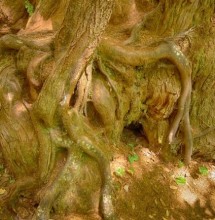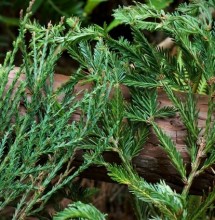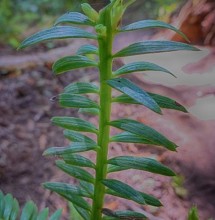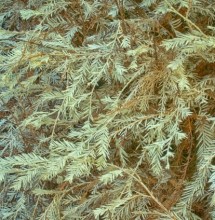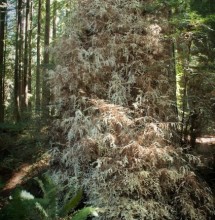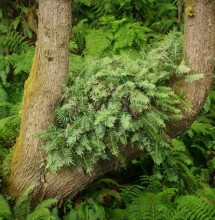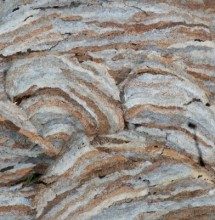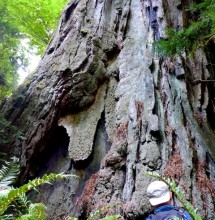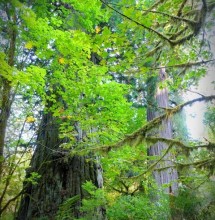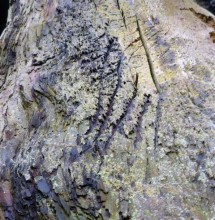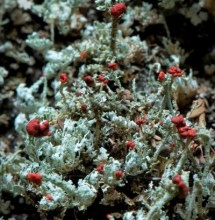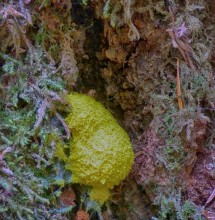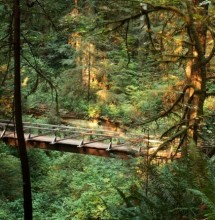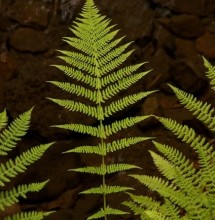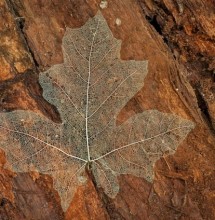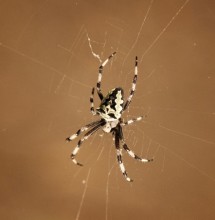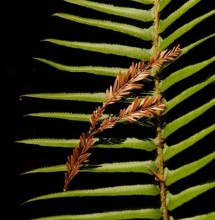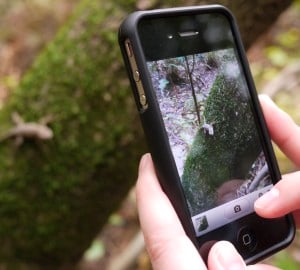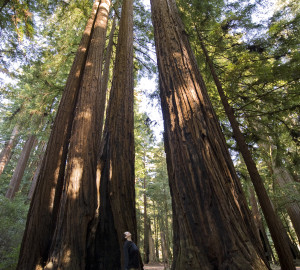Guest bloggers Doug and Joanne Schwartz – League members and dedicated volunteers – are serving this summer as our Redwood Explorers-in-Residence, exploring the northern parks, and ground-truthing and mapping the groves of ancient forest they find. Along the way, they’re documenting the many interesting plants, animals, and fungi they find in Redwood Watch, and blogging about their experiences. Continued from last week…
Over the past month, we have learned a great deal about the coast redwood forest ecosystem. Many of our lessons have come from our experiences walking miles of trails and bushwhacking through dense understory. We have enjoyed learning from knowledgeable and generous interpretative rangers, and from a variety of books and internet sources. We would like to share some of our observations and a few of the fascinating forest tidbits that we have discovered:
Western hemlock, “the octopus tree,” has leaves similar to those of redwoods and the strange characteristic of enveloping logs, rocks and other trees with tentacle-like roots. This provides a very interesting structure to support a tall tree and a quick key to identification.
At the very top of the redwood canopy are the trees’ tiny sun leaves. Closer to the ground, the leaves get progressively wider and become the flat shade leaves we normally associate with redwoods. Little redwood sprouts, only a foot or two tall, have broad, widely-spaced shade leaves to gather every bit of sun they can. An aberrant form of redwood leaves are those on albino or “ghost” redwoods, rare parasitic trees without chlorophyll. Their small white leaves contrast with the normal green foliage of their host non-albino redwood, and feel silky and waxy, almost like silicone rubber.
Deep-green licorice ferns grow here as epiphytes (plants that grow on other plants) high in old-growth redwood trees. They appear in clumps on giant burls and in the notches of side-trunk reiterations, and as mats on limbs and branches. We found them in other trees too, in similar well-supported spots. Redwoods have great, gnarly crowns which host a wide variety of plants and other life, these lush licorice fern gardens are large enough to be seen from our lowly vantage point.
This month, the duff beneath the redwoods was littered with fallen paper wasp nests in the mottled, muted colors of redwoods and other plants. The paper sheets are formed of material eaten by the wasps and deposited as onion-like skins around several layers of honeycomb structures.
Hiking a popular trail in Jedediah Smith Redwoods State Park, we heard the slow, clear pecking of a pileated woodpecker on an old snag. Once you know it, this sound cannot be confused with that from any other bird. We scanned the trunks and spotted him as he flew to a closer tree, where his bright red head and white and black body were spotlighted in a ray of the late afternoon sun. Then, we heard the similarly unmistakable cry of an osprey. We had encountered them throughout the forests for several weeks, so we looked in the direction of the fisher’s call, where we saw a Steller’s jay sitting on a branch. Through binoculars, we could clearly see its beak opening as it repeatedly sounded the osprey call. Corvids are talented mimics, and this one had clearly been around an osprey and adopted its piercing cry.
One Very Cool Tree, Indeed!
We have seen some of the biggest and tallest redwoods that exist in these northern forests, but among all these spectacular trees, a few stand out as personal favorites. One late August afternoon, our trek took us across a stream and deep into a section of woods without benefit of our usual black bear trails. We saw a few tiny fungi, some odd beetles under a piece of bark, and a Roosevelt elk doe before arriving at the boundary between the old-growth redwoods and the rest of the forest.
While we are not focused on measuring trees, a few here pique our curiosity. Our measurement technique of counting our arm spans around the trunk is simple and would make any forester laugh. One tree exceeds 95 feet in circumference, 19 of Joanne’s five-foot arm spans! Most of these lengths were over burl, not the normal standard of measurement, but representative of how we experience this tree. An 8- or 9-foot-diameter redwood standing nearby looks skinny by comparison.
This venerable tree has many stories to tell. A hole at eye level goes right through about a quarter of the tree, and it’s been hard hit by at least a few fires.
A series of bear scratches reach eight feet high on a broad plane of the tree’s base. These scratches, about 5 to 6 inches across, must have been made by a black bear, but we couldn’t imagine what an adult was doing clawing the tree several times, so high up. Grizzly bears regularly stretch this high, but their claw marks are closer to 8 inches wide, and of course grizzlies are no longer found in California… but, one could well have been here 100 years ago, just yesterday in this redwood’s life.
Finally, our special tree is heavily decorated by the scarlet fruiting of British soldier lichen and by a brilliant yellow slime mold.
Regrettably, it was too late in the day to search for openings in the forest from which we could view the crown of this amazing tree. It did catch a bit of afternoon sunshine for us just as we walked out, before disappearing into this grand forest.
Leaving the Tall Trees Behind… But We’ll be Back!
As our time hiking remote corners of the redwood forests to gather hundreds of GPS points comes to a close, we are filled with gratitude to Save the Redwoods League for giving us this opportunity. As usually happens when traveling, we have met some fascinating and warm people in the redwoods. These friends-in-passing include:
- The father guiding his enthusiastic 13-year-old daughter through the Tall Trees Grove on her first backpacking trip
- A family with two youngsters visiting many of the redwood parks as part of a four-year traveling education-through-nature experience;
- Nat, State Park staff naturalist in the visitor center at Prairie Creek Redwoods State Park, who cared enough to share his curiosity and resourcefulness with us on several occasions;
- The staff of a tiny town school who keep an open WiFi spot during the summer and invite park staff and visitors to use it. It was the fastest internet service we encountered in Humboldt and Del Norte Counties.
- Delightful people in the friendly town of Orick, near Prairie Creek: Betty, whose store sign advertises yeast, flower, salt and sugar, everything needed to bake when normal deliveries of bread are delayed; Charlie, who sells a great variety of produce from his garden and lets us in to pick what we want if it’s not on his sale tables; Sandy and Kirk, at a private camp, with stories of supporting the ultra-long-distance cyclists and runners who pass their way.
Always ready for our next exploration,
Doug and Joanne Schwartz
You can read Doug and Joanne’s other blogs here and find pictures of natural history from Doug and Joanne’s travels on their gallery at ExplorerDJ.SmugMug.com.
